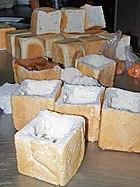バニーチャウ
Bunny chow/ja
コード スニペット
| バニーチャウ | |
|---|---|
 トッピングが乗った「マトンのクォーター」バニー | |
| 種類 | カレー、サンドイッチ、ブレッドボウル |
| フルコース | ランチ、ディナー、スナック |
| 発祥地 | 南アフリカ |
| 地域 | ダーバン |
| 考案者 | 南アフリカのインド系住民 |
| 提供時温度 | ホット |
| 主な材料 | パン、カレー |
バニーチャウは、単にバニーと呼ばれることもあり、南アフリカのインド系住民のファストフード料理である。白いパンをくり抜いたものにカレーを入れ、サラダを添えたもので構成される。ダーバンのインド系南アフリカ人の間で誕生した。南アフリカの様々なコミュニティでは、バニーチャウの原型に文化的な脚色が加えられたものが見られる。これは、パンの4分の1斤だけを使い、スカムバネ、コタ(「4分の1」)、またはシボボと呼ばれることがあり、この名前はバニーチャウから発展した南アフリカ料理であるスパトロと共通している。
歴史Template:ANchor
バニーチャウは、ダーバン, 南アフリカで誕生した。ダーバンにはインド系の住民が多く暮らしている。この料理の正確な起源については諸説あるが、1940年代に作られたとされている。第二次世界大戦中には南ローデシアのグウェロ(現在のジンバブエ)でも販売されており、現在でも旧名ガトゥーマとして知られる近隣の町カドマで販売されている。
バニーチャウの起源に関する話は、インド人移住労働者が南アフリカに到着した時代にまで遡る。ある説によれば、クワズールー・ナタール(ポート・ナタール)のサトウキビ農園で働くためにやってきたこれらの労働者は、長時間労働と短い休憩しか与えられていなかった。休憩中、労働者たちは当初、大きな葉の上に食べ物を広げていたが、これでは時間がかかり、休憩時間も短いため、食べ物を冷めさせずに素早くまとめる方法を見つけた— これがバニーチャウである。彼らが作ったパンはくり抜かれ、カレーや野菜が入れられた。これはプランテーションに持ち出すのにも便利であった。肉を詰めるようになったのは後になってからである。白いパンが使われたのは、伝統的なロティの不足と、その構造が弱かったためとも考えられる。そのため、地元で広く入手できる安価なパンが、カレーを入れるのに最適な容器となった。
Etymology

One story claims that a South African restaurant run by Banias (an Indian caste) first created the dish at a restaurant-café, called Kapitan's, on the corner of Victoria and Albert streets in Durban. Another tale opines that the origin of this handheld dish was due to Indian golf caddies not being allowed to publicly carry sharp cutlery like knives during apartheid. "Chow" in South African English is simply slang for "food" as well as the verb "to eat".
The traditional Indian meal was roti and beans, but the roti tended to fall apart as a take-away item. To solve this, the centre portion of a loaf of white bread was hollowed out and filled with curry, then the filling was capped with the portion that was carved out. The vegetarian version of the meal is sometimes known as a "beans bunny". An alternate, albeit unlikely, etymology is derived from a mondegreen of "bun" and "achar" (Indian pickles), though the latter are not usually included in the dish (unless as an accoutrement).
Cuisine

Bunny chows are popular amongst Indians and other ethnic groups in the Durban area. Bunny chows are commonly filled with curries made using traditional recipes from Durban: mutton or lamb curry, chicken curry, trotters and beans curry, and beans curry. Other varieties found across the country using less traditional Durban-Indian food include chips with curry gravy, fried sausage, cheese, eggs and polony. These are all popular fillings; the original bunny chow was vegetarian. Bunny chows are often served with a side portion of salad containing grated carrot, chilli and onion salad. Commonly known as sambals, this includes chopped tomatoes, onions, and green chilies served with white vinegar. Other sides include Indian pickles, such as mango pickle, lime or lemon pickle, vegetable pickles and other seasonal varieties which are pickled. A key desirable characteristic of a bunny chow is seen when gravy from the curry fillings soaks into the walls of the bread. Sharing a single bunny chow is not uncommon.
Bunny chows come in quarter, half and full loaves. When ordering a bunny chow in Durban, the local slang dictates that you need only ask for a "quarter mutton" (or flavour and size of your choice); colloquially, people would say, "Can I have a quarter mutton bunny?" Bunny chows are mainly eaten using the fingers; it is unusual to see locals use utensils when eating this dish.
Bunny chows were historically packaged in the previous day's newspaper. This is no longer common, and takeaway bunnies are more typically sold in "bunny boxes" which retain heat and prevent leaks from the curry.
Bunny chows are available in many small takeaways and Indian restaurants throughout South Africa. The price ranges from R 15 (US$1.01) for a quarter beans bunny or dhal, to R 50 (US$3.38) for a quarter mutton bunny, and generally one can multiply the price of a quarter by 3 or 4 to estimate the price of a full bunny. Bunny Chows are ideal for picnics, and beach trips.
Each year, the "Bunny Chow Barometer" is held in September on the south bank of the Umgeni River, just above Blue Lagoon (a popular Sunday picnic spot for Durban Indians), attracting numerous entrants from across the Durban Metro region to compete for the title of top bunny maker.
関連項目
| この記事は、クリエイティブ・コモンズ・表示・継承ライセンス3.0のもとで公表されたウィキペディアの項目Bunny chow(5 July 2025, at 09:05編集記事参照)を翻訳して二次利用しています。 |
